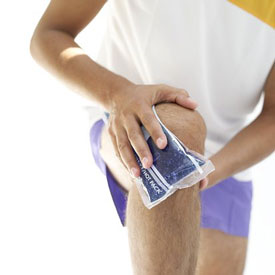 Mild muscle injuries create microscopic damage/tears to the muscle fibers, and scientists believe this damage, coupled with the inflammation that accompanies these tears, causes the pain.
Mild muscle injuries create microscopic damage/tears to the muscle fibers, and scientists believe this damage, coupled with the inflammation that accompanies these tears, causes the pain.
Sore muscles are usually caused by doing an activity you’re not used to (like running a marathon when you normally jog just a few miles or you have quickly increased your exercise intensity level or length of your workouts.
One question most people have, is when you have sore muscles, which is better…heat or ice. The best way to treat sore muscles is with cold therapy first and heat therapy later.
Cold Therapy:
Practitioners recommend icing the muscles immediately after activity to reduce blood flow to the area which will reduce the swelling and inflammation. You should apply a cold compress/pack for at least 20 minutes, every four to six hours for up to 2 days.
Heat Therapy:
After the first day of soreness, heat can be applied to the inflamed area, which will help sore and tightened muscles relax and will promote blood flow and circulation. Heat should be applied to the area for 20 minutes; up to three times a day.
Stretching The Muscles:
One of the best ways to prevent sore muscles is by easing your way into your activity or exercise routine. This can be achieved by using those targeted muscles in lighter exercise than you are going to be performing in the following minutes.
The most important step you can do to prevent sore muscles is to have a cool-down phase after any workout or physical activity. Right before finishing, include at least 10 minutes of light aerobic work such as walking followed by stretching. Stretching will also help to move the lactic acid out of your muscles.
Keep Hydrated:
If your muscles are sore from intense activities, your muscles are rebuilding themselves, and require lots of water. Remember to drink water while you work out and throughout the day.
Therapies That Can Help With Sore Muscles:
Massage – is used to relieve pain by working on the soft tissues, the muscles, tendons, and ligaments to improve muscle tone. Massage stimulates blood circulation and assists the lymphatic system and improving the elimination of waste throughout the body.
Acupuncture – is used to encourage the body to promote natural healing and to improve function. Acupuncture points stimulates the nervous system to release chemicals in the muscles that will either change the experience of pain, or will trigger the release of other chemicals and hormones which influence the body’s own internal regulating system.
eToims – produces painless deep twitch contractions that stretch and relax damaged muscles. This produces an inflow of fresh blood and tissue oxygenation to tired muscles as pain-producing chemicals simultaneously outflow from affected areas.
Dry Needling – The aim of dry needling is to achieve a local twitch response to release muscle tension and pain. dry needling can reduce pain, while increasing flexibility and range of motion by: stretching receptor in the muscle by stimulation, and drawing blood to the area, initiating the natural healing process.
It’s normal to have sore muscles after you work out, or play sports, just make sure you take care of them!

